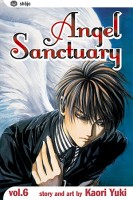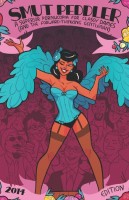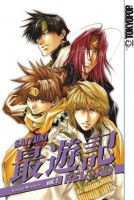My News and Reviews
As has been previously mentioned, a couple of weekends ago I attended the Toronto Comic Arts Festival (which I’ve apparently been going to for five years now). It took me a little longer than I had originally planned, but I did finally manage to post my random musings on TCAF 2017. In the post I write about some of the major highlights of the trip and attempt to summarize prominent themes that emerged during the panels that I attended. Last week I also spent a fair amount of time with my family in Ohio. I was already planning on going down for the long weekend, but that weekended turned out to be much longer than initially anticipated–my maternal grandmother passed away on Tuesday, so I left town on Thursday instead of Saturday. While the occasion was a sad one (though not entirely unexpected), it was wonderful to see so much of my family and everyone is doing really well considering. I also got to hear some great family stories and learned a bit more family history than I previously knew.
Unsurprisingly, I wasn’t really online much at all last week and was all sorts of distracted, so I’m sure there are plenty of things that I missed. However, The OASG had a great feature on Kazuhiro Fujita’s The Ghost and The Lady which combines a review and an interview with Finola Austin, the cultural consultant for the English-language edition of the manga. Seven Seas also made another series of interesting and exciting manga license announcements: Giant Spider & Me: A Post-Apocalyptic Tale by Kikori Morino, Fauna and the Dragonewts’ Seven Kingdoms by Kiyohisa Tanaka, Ultra Kaiju Anthropomorphic Project by Shun Kazakami, Saint Seiya: Saintia Shō by Chimaki Kuori, and Leiji Matsumoto’s original Captain Harlock.
Quick Takes
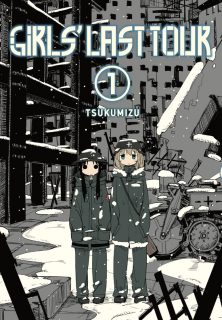 Girls’ Last Tour by Tsukumizu. There is a fairly common conceit in manga and anime which can basically be described as cute girls doing things. Though I’ll still happily read it, it’s a category of manga that doesn’t especially interest me and I don’t usually intentionally seek it out unless there’s an additional hook of some sort that I am curious about. In the case of Girls’ Last Tour, it was the manga’s post-apocalyptic setting and a recommendation from a friend that caught my attention. And I’ll admit: I enjoyed the first volume much more than I expected I would and definitely plan on reading more. For the most part I find Tsukumizu’s artwork appealing, although in general the character designs are less inspired than the backgrounds. Chito and Yuuri are two young women traveling together across the wasteland in search of food, fuel, and the comforts of home. At this point in the manga it’s unclear what brought about the end of civilization or even how many survivors there are. (Chito and Yuuri spend most of the first volume alone together, but at one point they do meet and briefly team up with a mapmaker, so they aren’t the only ones left.) The backstory may never be fully explained as Girls’ Last Tour is mostly about Chito and Yuuri’s everyday lives. Girls’ Last Tour is a surprisingly delightful and charming series although it it has a melancholy air to it as well.
Girls’ Last Tour by Tsukumizu. There is a fairly common conceit in manga and anime which can basically be described as cute girls doing things. Though I’ll still happily read it, it’s a category of manga that doesn’t especially interest me and I don’t usually intentionally seek it out unless there’s an additional hook of some sort that I am curious about. In the case of Girls’ Last Tour, it was the manga’s post-apocalyptic setting and a recommendation from a friend that caught my attention. And I’ll admit: I enjoyed the first volume much more than I expected I would and definitely plan on reading more. For the most part I find Tsukumizu’s artwork appealing, although in general the character designs are less inspired than the backgrounds. Chito and Yuuri are two young women traveling together across the wasteland in search of food, fuel, and the comforts of home. At this point in the manga it’s unclear what brought about the end of civilization or even how many survivors there are. (Chito and Yuuri spend most of the first volume alone together, but at one point they do meet and briefly team up with a mapmaker, so they aren’t the only ones left.) The backstory may never be fully explained as Girls’ Last Tour is mostly about Chito and Yuuri’s everyday lives. Girls’ Last Tour is a surprisingly delightful and charming series although it it has a melancholy air to it as well.
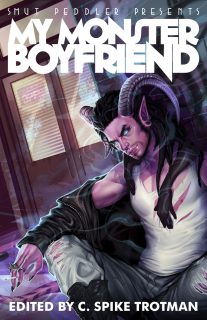 My Monster Boyfriend edited by C. Spike Trotman. Smut Peddler started as a series of minicomics before blossoming into a series of anthologies. My Monster Boyfriend is the first thematic Smut Peddler project as well as being the first Smut Peddler anthology to feature full-color artwork. The stories in My Monster Boyfriend are also longer than the ones included in the series’ previous installments–the anthology features ten erotic comics, the work of fourteen different creators. Unlike most of the comics anthologies that I’ve recently read, I was actually already familiar with most of the contributors to My Monster Boyfriend. The volume has a great lineup and I was not at all disappointed with the collection. I was particularly pleased to see the representation of a wide array of genders and sexualities. My Monster Boyfriend continues the sex-positive, queer-friendly trend of Smut Peddler. Considering the volume’s motif (inhuman men and their sexual partners), all of the stories included are fantastic by nature. However, there is still wonderful variety in style, approach, and genre. Some of the stories are comedic while others are quite serious; some comics lean towards horror while others tend towards romance. My Monster Boyfriend can in turns be sweet, scary, and sentimental.
My Monster Boyfriend edited by C. Spike Trotman. Smut Peddler started as a series of minicomics before blossoming into a series of anthologies. My Monster Boyfriend is the first thematic Smut Peddler project as well as being the first Smut Peddler anthology to feature full-color artwork. The stories in My Monster Boyfriend are also longer than the ones included in the series’ previous installments–the anthology features ten erotic comics, the work of fourteen different creators. Unlike most of the comics anthologies that I’ve recently read, I was actually already familiar with most of the contributors to My Monster Boyfriend. The volume has a great lineup and I was not at all disappointed with the collection. I was particularly pleased to see the representation of a wide array of genders and sexualities. My Monster Boyfriend continues the sex-positive, queer-friendly trend of Smut Peddler. Considering the volume’s motif (inhuman men and their sexual partners), all of the stories included are fantastic by nature. However, there is still wonderful variety in style, approach, and genre. Some of the stories are comedic while others are quite serious; some comics lean towards horror while others tend towards romance. My Monster Boyfriend can in turns be sweet, scary, and sentimental.

